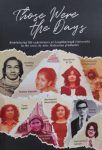Ulu Kedah Culinary & Hospitality
Trains are just enticing: picture windows, freedom to move around, time to bury yourself in a book or socialize, yet moving smoothly at a speed that does not upset your cup of tea. Last month, I took the ETS to Sungai Petani, meeting up five other friends with their wives for a lesson on history, culinary and hospitality. It turned out to be a delightful three-day trip down memory lane for those born and raised in Kedah.
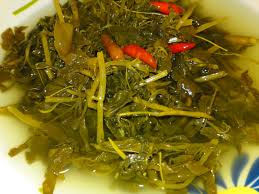
For me at least, having overstayed my welcome in the big city of Kuala Lumpur for the last 46 years, and now completely retired, the trip presented the perfect opportunity to reconnect with the serenity of kampong life once more….the green paddy fields stretching as far as the eyes could see, the spectacular mountains in shades of green, the soft breeze blowing, carrying with it a rhythm of kampong chatter.
I constantly visited Kedah in the past, at least to reconnect with whatever was left of my early life: my nieces, my nephews, my cousins but largely my memories. The migration of kampong folks to the big city seeking new opportunities, have brought with them practices and tradition peculiar to Kedah, especially the cuisines. I have tasted Laksa Kedah, Pindang Ikan Temenung, Curry Ikan Kering, Asam Pedas Keladi, while eating out around Kuala Lumpur but I have never heard of Jeruk Maman, let alone tasted it. Jeruk Maman is part of Ulu Kedah cuisine, popular among the kampong folks in the district of Baling, Sik and Kuala Nerang.
Maman plant, is a national treasure, according to a farmer growing it on a large scale in Gemencheh, Negeri Sembilan. The maman leaves, bitter though they were, actually prevented a war with the Johorians at one time, only because the Johorians fell in love with the maman dish served (initially, an idea as a nasty prank) (http://www.straitstimes.com, October 2017). The scientific name for Maman plant is Cleome Gynandra and it is popularly-grown in Negeri Sembilan and Terengganu. The name Maman most probably originated from the name of the town Kemaman in Terengganu.
Maman leaves is sometimes used to cook rendang. But it is Jeruk Maman that I am more curious about. Jeruk Maman is prepared using young leaves or shoots, salt, water and some cooked rice. The young maman leaves and some stems are placed in a plastic, together with some generous amount of salt and topped by a cup of cooked rice, and a cup of cold water, all placed aside to allow fermentation. They are best eaten with rice, preferably steaming hot, but sometimes made into a kind of kerabu or eaten plain with some shallots and chilli padi. It was my first time. I tasted this dish during a generous dinner spread in Kampong Bukit Pak Kuning, Kuala Ketil, courtesy of Taib’s family. Kuala Ketil is a small town about 21 kilometers from Sungai Petani by road.
The entire Taib’s family practically participated in the cooking of dinner on that particular evening, but for a family running a restaurant next door on a daily basis, cooking dinner for 16 people was no big deal. It was a dinner drawn out over two hours of eating, interspersed with endless conversations and sometimes, thunderous laughter. I remember changing seats three times just to make sure everyone were comfortable and had a good proximity to the dishes.
In Kampong Sintok Bugis , in the district of Kota Kuala Muda, we had another big spread of lunch, courtesy of Ismail’s family. The family served fried meehoon, fried kuey teow, nasi lemak, and many other dishes. But the one thing I have never tried before was Nira drink. Nira (or Neera) is a sweet natural drink made from the Nipah palm or mangrove palm, native to the coastlines of the Indian and Pacific Oceans. Its scientific name is Nypa Fruticans. It seems Nipah palm produces a sweet edible sap collected in a bottle or plastic normally fitted to the trunk. The sap can be turned into a variety of products such as gula nipah and cuka nipah or vinegar. The Nipah sap can also be fermented to produce alcohol. Cars fueled by alcohol is not a new idea at all. For decades experimentation with alcohol and bio-fuels has been conducted.
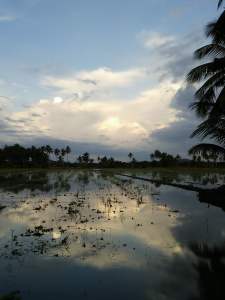
To top it all off, was the brunch in Kampong Setar, in the district of Yan. After brunch, some of us pulled out a bike each (courtesy of Salleh’s family). I hesitated at first. But after a few minutes, I was able to balance myself and managed to stay comfortable on the bike in perpetual motion. With the breeze softly blowing in my face, I felt an overwhelming rush of nostalgia. I remember visiting cousins who lived in wooden houses among paddy fields when I was young. I cycled almost everywhere in the 1960s. My initial plan was to photograph a real farmer on his rounds on the old bicycle complete with a big straw hat and a parang. But we could not find one.
If you look to the left, there is the majestic Gunong Jerai, with clouds still hanging around them like white cotton balls . And to the right, are paddy fields half buried under irrigation water, with luscious green paddy plants sprouting from underneath. Miles and miles of paddy fields is a common sight since Kedah is an agricultural state and the biggest producer of rice. I can imagine Salleh’s uncle cycling around the bunds after working the fields in the early hours of the morning many many years ago.
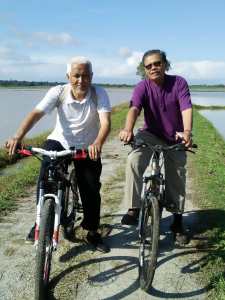
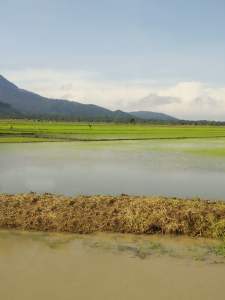
Before the close of the evening of the second day, Ismail took us for Mee Udang (or prawn noodles) in Kampong Pulau Sayak in Kota Kuala Muda. There are about six or seven such stalls in the kampong. The beach-front restaurant called Yaakob made a delicious Mee Udang, using prawns from the sea . To be fair, I didn’t try other Mee Udang stalls. But this stall was exceptional because of the picture-perfect, fast-fading sunset, laid out in front of us, the sun casting its last colourful hues over the sea as we dined.
If you had a chance to visit Sungai Petani on your way up north towards Langkawi Island, try stopping at the Hotel Seri Malaysia, a convenient stop since it is just opposite the train station. But there is a beautiful homestay nearer to Gunong Jerai if you prefer.

“People will forget what you said, forget what you did, but people will never forget how you made them feel” and Taib’s family, Ismail’s family and Salleh’s family all made us feel extremely welcome in their homes. The 2Fs: Food and Friendships, made me feel truly blessed……of course it’s not always about food, but who you eat with that matters most to me.
(*Yaakob Mee Udang Segar, Pulau Sayak, Kota Kuala Muda, Kedah, Google or call 019-542 9812 if you are lost).
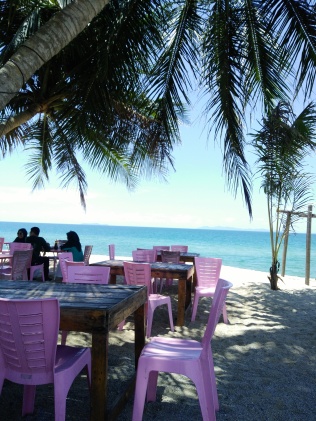
2 Months of Pain Over Little Red Pills
It was a real hot, dry afternoon with no sign of relief from the rain clouds. I could feel beads of sweat trickling down my neck and elsewhere even as we sat underneath the shade of some coconut trees with the wind softly blowing from the sea (Fig 1). Even cold, sweet pineapple juice in tall glasses could not douse our hot discussion about drug use and remand prison time with two pill kuda users.
Pil Kuda is locally referred to as methamphetamine. In Kelantan, its retail price is RM10 but in Terengganu, it is RM15 – RM20. The pills are smuggled from Thailand into Kelantan and are what some people term as a poor man’s drug. Ketamine is called pill kuda because its use was for calming horses. Then we have syabu or pure methamphetamine, heroin, ganja (whose real medicinal value is as a pain killer), cocaine (like cocaine tooth drops to relief tooth ache) and ecstasy party pills (methylenedioxymethamphetamine). I did not realize how bad the drug problem in Terengganu was until that morning in Permaisuri.
Seated in the front row of the lower court that morning, I had an opportunity to listen to many remand cases while waiting for the specific case of interest to be mentioned. It seemed that out of 24 remand cases mentioned that morning, 23 were drug related and all involved Malays. This is an alarming trend. One remand case I heard was a well-dressed 65 year old man with dark glasses called Cikgu (teacher in Malay). He looked more like a headmaster of some remote school than a drug user or a drug peddler. The 65 year old drug user made an appeal for the magistrate to reduce the charge of RM6000. He made all attempts using poetic language in his appeal to impress the magistrate. The magistrate, a sweet young lady with hijab and beautiful painted lips, granted him a reduction of RM2,500. But he was far from satisfied. As he was being led out by a policeman, I heard him swore under his breath, with a look of disgust on his face. The “headmaster-look” completely disappeared and in its place, the face of an unrepentant drug peddler.
A young drug user on remand failed to attend the lower court hearing that morning , forcing his old man to present himself at the court since he was the one who posted bail. In Malaysia, you can pay bail to go home instead of going to jail while waiting for hearing. The lady magistrate did not hide her disgust and threatened to take away the old man’s bail money if the son failed to attend the next hearing. Then there was a young man about 20 years old who presented himself. He was dressed in short-sleeved tee shirt revealing old scars on his arms indicative of intravenous drug use. Almost all prisoners made gestures of defiance as they were being lead away. Many were young men maybe in early twenties and a few seasoned-looking hard-core drug users or drug pushers. One was a fresh-looking man in his early forties whose charges were duly dropped. And later when we met him outside, he related to us how he tried to help my friend’s worker during a raid by ADDK. But having watched too much American cop movies, his story made us a little skeptical. Could he be an informant?
Mezoh, a Patani who was working on my friend’s house, is a recreational drug user, resorting to pil kuda once or twice a week when he felt a physical burnout after his daily work on site. He is only 45 years old and very lean-build. Although from Patani, he spoke little Thai. On the day he was arrested in an ADDK (Agensi Anti-Dadah Kebangsaan or National Anti-Drugs Agency) raid on a house in Permaisuri, 2 months before, he was with some friends, smoking. The raid happened suddenly and quickly. ADDK officers appeared out of nowhere as if an informant had a hand in it. Mezoh suddenly found himself in jail waiting to be charged (Fig 2). If the court decides to put you on remand, it means you will go to prison until your hearing at a magistrate’s court. Mezoh was kept in jail for two months due to investigation by the police who had to be extra-careful with cases involving foreigners.
Mezoh related how much he suffered mentally and physically while on the two-months remand in Merang. 65 prisoners were confined to a space of about 30 feet by 30 feet. Space was so tight that if he left his spot to ease himself, he would find his space “gone” by the time he got back, duly occupied by another prisoner. The same space was also used for sleeping and there were no beds. Food was scarce. Prisoners were allowed five spoons of rice twice a day. Tea drinks were without any sugar and sometimes prisoners fight over tea. He looked like he did not lose much weight but then none of the prisoners did any physical work. They were not even allowed to attend weekly Friday prayers. Mezoh thought such conditions were unheard of in a Thai prison, on remand or not.
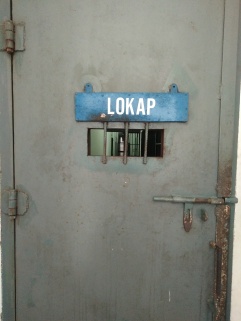
Lae, a 60 year old seasoned drug user, was constantly in and out of jail for drug use making him almost resilient. How he “got over” the drug habit was actually a result of an attachment to a tablir group during his parole years. It seemed to have straightened him out a bit, although it is anybody’s guess when he would cave in next. He had been taking drugs on and off since he was 20. Now he seemed to show some promising signs of discipline and resolve. He now keeps a dairy to jot down his duas and daily expenses from the little money his children gave him. This was seen as positive step towards recovery.
It made me wonder why these youngsters and even a few elderly men like Mezoh and Lae (residents of Mangkuk, resort to drug use? According to a 2018 AADK survey of drug addicts, (https://www.adk.gov.my) by state, showed Kelantan to have the highest number of drug addicts at 4,153 followed by Kedah at 2,693. Out of 25,267 drug cases surveyed, 82% are Malays, 6.3% are Indians, and 96% of this number are males.
Among the drug users, the top most prone to drug abuse are the unemployed (3,650), the general workers (5621) and the part time workers (8,086). Socio-economic factors such as poverty and lack of employment opportunity are cited as some of the causes for high drug use among fishermen, according to Malaysian Crime Prevention Foundation (MCPF)(August 2017,nst.com.my).
Malaysia may have the strictest drug laws in the world, but the rising trend in drug abuse may require a rethink of its drug control strategies.
(April 2019, 1222 Words)
I Have Never Flown A Kite
My mother, unschooled though she was while she was still alive, taught me one thing about life and relationships. She used to say “Being in a relationship, is like flying a kite – you pull a little, let go a little so the string won’t break”. I am not too sure if that valuable lesson did anything to my relationships but it sure did not improve my kite flying ability. The closest experience I ever had with kites was when my brother allowed me to hold the harness of his airborne kite very briefly when I was 7 years old.

I confess I am more into ceramics and oil painting but kite design is somehow intriguing to me. I made a trip to Kota Bharu recently to meet two kite makers, an arrangement made by a retired Prof Abd Aziz Shuaib, who taught architectural design in UMK. He happened to be an ardent traditional craft enthusiast. That morning when we reached his beautiful house near Pantai Cahaya Bulan, I was surprised to find a kite maker of Chinese blood in an arguably 98% Malay tradition. His name was Tan Sheng Hai. The other artisan was supposed to be Anuar, a young man about 30 years old, son of the late legendary kite maker, Pak Shafie Jusoh, who used to launch his Wau Bulan on Pantai Geting beach on the outskirts of Tumpat.
While one has made it big commercially at such a young age of 30, with one workshop and a thriving business, selling his enormous 7 feet wide kites to Italian tourists for a neat sum of five thousand ringgit, the other remained a passionate artisan, working from the house at 53 years of age. Tan Sheng Hai is an active member of kite associations and participated in various local and international kite competitions.
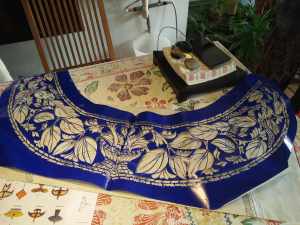
Tan grew up in predominantly Malay communities throughout his life. Growing up in Malay communities exposed him to Malay and Siamese traditions like wayang kulit, dikir barat, menora, mak yong to name a few. Tan moved around a lot during childhood even staying in Tanah Merah. He was brought up by his grandmother in Kampong Kulim Wakaf Baru, Kelantan. While he lived in Wakaf Baru, Tan was surrounded by neighbours who spoke Siamese so Tan could speak both Siamese and Malay beside his mother tongue, Hokkien.
About figure – An intricate design or pattern ready to be tebuk or cut out to be pasted onto layers of colored paper in a 4 feet wide kite frame.
He showed keen interest in kite making since school days. At 10 years old he made his first kite. At 15, he made his first big kite. A big kite could measure as wide as 10 feet from one wing tip to the other or 4 feet as in Fig 2 above. Some of the popular traditional kites are Wau Bulan, Wau Puyuh, Wau Barat, Wau Merak, Wau Kikik, Wau Kuching, Wau Jalabudi to name a few. Tan’s first real entry into kite competition was upon encouragement by his father who was also an active kite maker himself. Anuar , the young man in a hurry, entered the kite world at age 16. Upon his father’s insistence (when he was in secondary school), he entered a competition but did not quite make it.

What makes kites fly? What is the science behind kites? The four forces of flight – Lift, Weight, Drag and Thrust, affect kites as they affect aeroplanes and anything else that flies (https//airandspace.si.edu, Mike Hulslander, 2012). To launch the kite into the air, the force of lift must be greater than the force of weight. To keep the kite flying steady, the four forces have to be in balance. Lift must be equal to weight while thrust must equal drag.
Lift is the upward force that pushes the kite into the air. Lift is generated by differences in air pressure, which are created by air in motion over the body of the kite. The force of weight pulls the kite towards the earth. Thrust is the forward force that propels the kite in the direction of the motion. While an aeroplane generate thrust with its engines, a kite rely on tension from the strings and moving air. Drag is the backward force that acts opposite to the direction of the motion. Drag is caused by the difference between front and back of the kite.
And to think that 7 or 8 year old boys, some of whom didn’t even know how to read, living in the kampongs during the 1960’s times of innocence, have actually crafted simple diamond kites (in the shape of Wau Kikik) using bamboo sticks and newspaper, then flew the kites and kept them flying in the air, truly amazed me now. We thought nothing of it back then.
That Saturday morning at breakfast of nasi tumpang et al, a gesture of Kelantan goodwill, Tan explained the play of factors affecting the flight of kites. He mentioned about teraju, the three strings that control the flight of a kite. Manipulating this teraju (Fig 3) requires skill. But the most interesting gadget was the busor. Tan explained that a busor is a structure made of bamboo, shaped like a bow. The busor is fixed to the back of the wing of the kite. Once the kite flies, it will make a sound similar to waauuu…and that, it seemed, was how the name wau was given to our Malaysian kites.
Happy flying…and watch out for my next post when I will catch up with Anuar flying his big kite on the beach of Pantai Cahaya Bulan.
(10 January 2019)
THE BEDOUIN
Going down the road towards Madinah, reminded me of one particular taxi driver, who drove us from the Hajj terminal to Madinah on one of those soul cleansing trips. Since most passengers were flying into Jeddah for umrah, we were brought to the Hajj terminal instead. Despite the crowd, the immigration processed the passengers fairly quickly that evening and we were soon out of the terminal.
About figure – Women pilgrims leaving the Masjid Nabawi after prayers
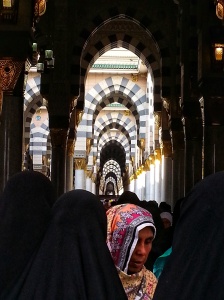
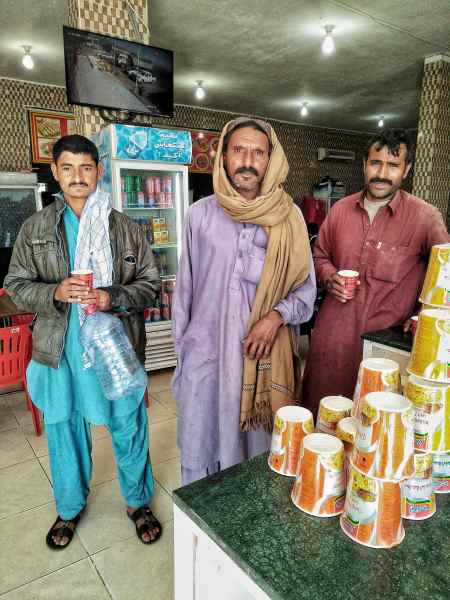
Going down the road towards Madinah, reminded me of one particular taxi driver, who drove us from the Hajj terminal to Madinah on one of those soul cleansing trips. Since most passengers were flying into Jeddah for umrah, we were brought to the Hajj terminal instead. Despite the crowd, the immigration processed the passengers fairly quickly that evening and we were soon out of the terminal.
About figure – Three lorry drivers stop at R&R on Highway 15 between Makkah & Madinah
Going down the road towards Madinah, reminded me of one particular taxi driver, who drove us from the Hajj terminal to Madinah on one of those soul cleansing trips. Since most passengers were flying into Jeddah for umrah, we were brought to the Hajj terminal instead. Despite the crowd, the immigration processed the passengers fairly quickly that evening and we were soon out of the terminal.
Once out of the terminal, we went looking for a taxi. Finding a taxi to take us to Madinah proved rather troublesome since there were very few private taxis at the Hajj terminal. One taxi runner quoted SAR1500 just to take us the distance of 250 kilometers away. We thought it was rather steep. We were then directed to a private taxi presumably an arrangement of mutual benefit for both runner and taxi driver. After the SAR1500 shocker, any lesser offer was deemed reasonable. Later we found an even cheaper fare of SAR500, but only if taken from the international terminal. It was already late in the night and we settled for the only taxi-driver to drive us to Madinah in his Toyota sedan for SAR1000.
The taxi-man, Muhamad, was a Bedou, for the Anglicised term “Bedouin”. The word Bedouin comes from the Arabic word Badawi which means “desert dweller”. Badawi are nomadic Arab people who have historically inhabited the deserts of North Africa, Arabic peninsula, Iraq and the Levant. The Arabic term Bedouin was traditionally used to differentiate between nomads, who made a living by raising livestock and those who worked on farms or lived sedentary lives in towns.
Bedouins tend to be small and thin. One reason for this is that food is scarce in the desert. But Bedouins love freedom thus the appeal for nomadic life. The number of true nomadic Bedouins however is dwindling. There may be less than 3% nomads left in Iraq, Libya or Saudi Arabia. According to Wikipedia (https://en.m.wikipedia.org), there are over 10 million in Sudan, about 2 million in Algeria, some in Egypt, Iraq, UAE, Syria, Saudi Arabia, Yemen, Libya etc.
Calmness and patience are valued traits. But the one thing that struck me that particular evening was Mohamad’s Bedouin hospitality. Bedouins, it seemed are well known for gestures like breaking bread with a stranger. Since we wanted to reach Madinah before 2 am, we didn’t stop to have a bite to eat before boarding the taxi. Needless to say we were grateful when Muhamad stopped along the highway and bought us cups of good strong coffee with a pinch of cardamon added. Bedouin kahwa is a strong aromatic coffee made with cardamon powder, saffron and rosewater. Later on along the journey he again bought us bananas and juice.
Arab drivers in Saudi were not much different from Malaysian drivers. They both have little patience when it comes to driving. I have seen similar mercurial drivers on highways and roads in Malaysia. Muhamad, small built, his face brown and drawn, probably in his forties (though he did look older, maybe because of the dry desert winds), was blowing his horn ever so often when he wanted to overtake other vehicles. He seemed like a dangerous driver, keeping to the fast lane and weaving in and out between trucks and buses while overtaking. Even though we were exhausted from the flight and the journey, I couldn’t sleep a wink. I was rather anxious watching the way Muhamad drove. I thought 75% of road accidents were caused by young Arab drivers but Muhamad was in his forties. One driver had his headlights on and kept pressing the pedal as if saying “Get out of my way”.
It was close to midnight and Muhamad was probably very sleepy. He found many innovative ways of keeping awake while driving on the highway. He sometimes turned on the radio way up playing traditional Bedouin music, singing and clapping loudly. And as if he suddenly remembered we were seated behind, he would turn down the music. Then he would unwound his head-cloth, put on his keffiyeh and silence returned as he drove quietly on. Sometimes he would smoke and this routine he would repeat every now and then throughout the 250 kilometers journey.
We arrived in Madinah in the wee hours of the morning. We had little exchanges with Muhamad since he knew absolutely no English and we do not speak Arabic. He had no use for the GPS to locate the hotel. All he did was stop fellow drivers along the way. After doing this for a number of times, one driver relented to show us the way. What a colorful character Muhamad was, reminding me of Lawrence of Arabia movie…. a Bedouin with a curved sword in a scabbard ornamented with silver, laid across his knees, or the Arab-speaking nomads in Hugh Kennedy’s “The Great Arab Conquests ”, who rode their horses over 200 miles a day to spread Islam. It seemed the Bedouins possess the same endurance, strength and loyalty as the Arabian horses they rode.




